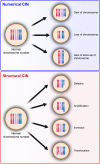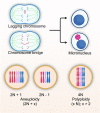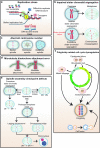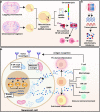The two sides of chromosomal instability: drivers and brakes in cancer
- PMID: 38553459
- PMCID: PMC10980778
- DOI: 10.1038/s41392-024-01767-7
The two sides of chromosomal instability: drivers and brakes in cancer
Abstract
Chromosomal instability (CIN) is a hallmark of cancer and is associated with tumor cell malignancy. CIN triggers a chain reaction in cells leading to chromosomal abnormalities, including deviations from the normal chromosome number or structural changes in chromosomes. CIN arises from errors in DNA replication and chromosome segregation during cell division, leading to the formation of cells with abnormal number and/or structure of chromosomes. Errors in DNA replication result from abnormal replication licensing as well as replication stress, such as double-strand breaks and stalled replication forks; meanwhile, errors in chromosome segregation stem from defects in chromosome segregation machinery, including centrosome amplification, erroneous microtubule-kinetochore attachments, spindle assembly checkpoint, or defective sister chromatids cohesion. In normal cells, CIN is deleterious and is associated with DNA damage, proteotoxic stress, metabolic alteration, cell cycle arrest, and senescence. Paradoxically, despite these negative consequences, CIN is one of the hallmarks of cancer found in over 90% of solid tumors and in blood cancers. Furthermore, CIN could endow tumors with enhanced adaptation capabilities due to increased intratumor heterogeneity, thereby facilitating adaptive resistance to therapies; however, excessive CIN could induce tumor cells death, leading to the "just-right" model for CIN in tumors. Elucidating the complex nature of CIN is crucial for understanding the dynamics of tumorigenesis and for developing effective anti-tumor treatments. This review provides an overview of causes and consequences of CIN, as well as the paradox of CIN, a phenomenon that continues to perplex researchers. Finally, this review explores the potential of CIN-based anti-tumor therapy.
© 2024. The Author(s).
Conflict of interest statement
The authors declare no competing interests.
Figures







Similar articles
-
Can a Liquid Biopsy Detect Circulating Tumor DNA With Low-passage Whole-genome Sequencing in Patients With a Sarcoma? A Pilot Evaluation.Clin Orthop Relat Res. 2025 Jan 1;483(1):39-48. doi: 10.1097/CORR.0000000000003161. Epub 2024 Jun 21. Clin Orthop Relat Res. 2025. PMID: 38905450
-
Paradoxical relationship between chromosomal instability and survival outcome in cancer.Cancer Res. 2011 May 15;71(10):3447-52. doi: 10.1158/0008-5472.CAN-10-3667. Epub 2011 Jan 26. Cancer Res. 2011. PMID: 21270108 Free PMC article.
-
A survey of chromosomal instability measures across mechanistic models.Proc Natl Acad Sci U S A. 2024 Apr 16;121(16):e2309621121. doi: 10.1073/pnas.2309621121. Epub 2024 Apr 8. Proc Natl Acad Sci U S A. 2024. PMID: 38588415 Free PMC article.
-
Management of urinary stones by experts in stone disease (ESD 2025).Arch Ital Urol Androl. 2025 Jun 30;97(2):14085. doi: 10.4081/aiua.2025.14085. Epub 2025 Jun 30. Arch Ital Urol Androl. 2025. PMID: 40583613 Review.
-
Targeting chromosomal instability in patients with cancer.Nat Rev Clin Oncol. 2024 Sep;21(9):645-659. doi: 10.1038/s41571-024-00923-w. Epub 2024 Jul 11. Nat Rev Clin Oncol. 2024. PMID: 38992122 Review.
Cited by
-
Genetic Characteristics of the Rat Fibroblast Cell Line Rat-1.Cells. 2024 Dec 29;14(1):21. doi: 10.3390/cells14010021. Cells. 2024. PMID: 39791722 Free PMC article.
-
High-resolution analysis of human centromeric chromatin.Life Sci Alliance. 2025 Jan 23;8(4):e202402819. doi: 10.26508/lsa.202402819. Print 2025 Apr. Life Sci Alliance. 2025. PMID: 39848706 Free PMC article.
-
CDK-dependent phosphorylation regulates PNKP function in DNA replication.J Biol Chem. 2024 Nov;300(11):107880. doi: 10.1016/j.jbc.2024.107880. Epub 2024 Oct 11. J Biol Chem. 2024. PMID: 39395804 Free PMC article.
-
Targeting epigenetic regulators as a promising avenue to overcome cancer therapy resistance.Signal Transduct Target Ther. 2025 Jul 18;10(1):219. doi: 10.1038/s41392-025-02266-z. Signal Transduct Target Ther. 2025. PMID: 40675967 Free PMC article. Review.
-
LIMK2 promotes centrosome clustering and cancer progression by activating MST4-mediated phosphorylation of NPM1.Oncogene. 2025 Aug 7. doi: 10.1038/s41388-025-03518-6. Online ahead of print. Oncogene. 2025. PMID: 40775397
References
-
- Wild, C., Weiderpass E., & Stewart B. W. (eds) World Cancer Report Cancer Research for Cancer Prevention (International Agency Research on Cancer, 2020). - PubMed
Publication types
MeSH terms
Grants and funding
- 32070715/National Natural Science Foundation of China (National Science Foundation of China)
- 32270778/National Natural Science Foundation of China (National Science Foundation of China)
- 82173029/National Natural Science Foundation of China (National Science Foundation of China)
- 82372655/National Natural Science Foundation of China (National Science Foundation of China)
- CSTB2022NSCQ-MSX0612/Natural Science Foundation of Chongqing (Natural Science Foundation of Chongqing Municipality)
LinkOut - more resources
Full Text Sources
Medical

